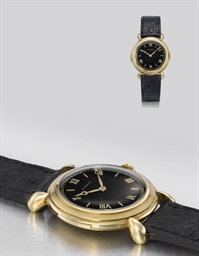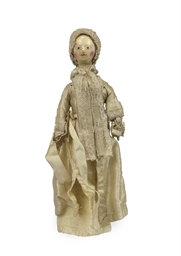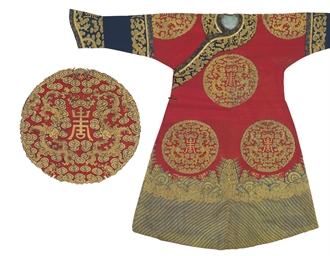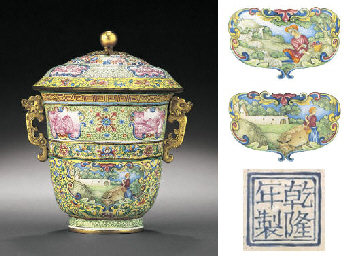A very rare mid-18th century French ormolu grande sonnerie striking mantel clock of two-week duration, with alarm and repeatEtienne Lenoir, a Paris. The case attributed to Robert Osmond.
The case surmounted with an impressive urn with berry finial and laurel swags, over a pierced waist set with musical trophies, the sides cast with berries and acanthus leaves and silk-backed sound frets, all on an elaborately shaped base with heavy cast foliate scrollwork.
The 5.25 inch white enamel Arabic and Roman dial signed Etienne LeNoir A Paris under elaborately pierced gilt brass dragon hands and the tapering steel alarm-setting hand, all framed by a well cast bezel.
The triple spring barrel movement contained within two separate pairs of brass plates, the upper movement of tapering form, with anchor escapement, pull repeat system and large numbered outside countwheel, linked via a vertical rod to the lower set of plates set in the base of the clock to control the repeat and alarm functions, with larger engraved outside countwheel. The upper backplate engraved Etienne Le Noir AParis No. 454. Ticking, striking, operational alarm and repeat. Together with a delicate silk suspension pendulum.
32cm wide x 18cm deep x 49cm high, (12 1/2in wide x 7in deep x 19in high)FootnotesProvenance
The Collection of Mcihael Cory-Wright, Esq;
Christies, London, 11 June 1998;
Gilbert de Vries, Horlogerie de Collection Ancienne et Contemporaine, Paris, November 1998.
Exhibited
TEFAF, Basel and sold with accompanying paperwork including a Certificate of Cultural Property dated December 1998 and instructions.
Etienne Lenoir (also spelled Le Noir) was born in Paris in 1660 to a horological family. His father, Simon, was a horologist, and Etienne's grandfather, Jean (or Jehan) was Horloger du Roi in 1552. Etienne, perhaps unsurprisingly therefore also became a horologist, though the details of his apprenticeship are unclear.
It is likely however, that he was apprenticed to his father. He married Marie-Anne Gamonet in 1696 and they had two children, Pierre-Etienne, born in 1698, and Etienne, born a year later. Etienne senior was known to have made turret clocks, as well as making a varied output of gold and silver watches, marquetry clocks, and bronze figural mantel clocks, among others. He died in 1739.
Etienne Junior would become a horologist as well; he married in 1717 and was recorded working out of Goldsmiths' Quay in 1743 and was still recorded as late as 1778. His son, also named Pierre-Etienne and born in 1724, was an accomplished horologist and worked with his father in Goldsmiths' Quay. It appears that Pierre joined his father in business around 1743, shortly after Pierre's marriage that year. Unfortunately, both father and son signed their work 'Etienne Le Noir' which makes distinguishing the work quite difficult. Their workshop was known simply as 'Le Noir' and it would continue trading until 1820. Pierre-Etienne has been recorded as late as 1791, but it is unclear when he or his father died.
The Lenoir dynasty was associated for generations with quality and extravagance and included everything from an elaborate bronze elephant automaton clock to a delicate gold repeater pocket watch.
Tardy, Dictionnaire des Horlogers Français, 127th edition, Aubenas: Lienhart et Cie, 1972.
An identical clock case by Robert Osmond, minus the foliate scrolling to the base is illustrated in H. Ottomeyer and P. Proschel, Vergoldete Bronzen, 1986, p.542, fig.1.
A very rare mid-18th century French ormolu grande sonnerie striking mantel clock of two-week duration, with alarm and repeatEtienne Lenoir, a Paris. The case attributed to Robert Osmond.
The case surmounted with an impressive urn with berry finial and laurel swags, over a pierced waist set with musical trophies, the sides cast with berries and acanthus leaves and silk-backed sound frets, all on an elaborately shaped base with heavy cast foliate scrollwork.
The 5.25 inch white enamel Arabic and Roman dial signed Etienne LeNoir A Paris under elaborately pierced gilt brass dragon hands and the tapering steel alarm-setting hand, all framed by a well cast bezel.
The triple spring barrel movement contained within two separate pairs of brass plates, the upper movement of tapering form, with anchor escapement, pull repeat system and large numbered outside countwheel, linked via a vertical rod to the lower set of plates set in the base of the clock to control the repeat and alarm functions, with larger engraved outside countwheel. The upper backplate engraved Etienne Le Noir AParis No. 454. Ticking, striking, operational alarm and repeat. Together with a delicate silk suspension pendulum.
32cm wide x 18cm deep x 49cm high, (12 1/2in wide x 7in deep x 19in high)FootnotesProvenance
The Collection of Mcihael Cory-Wright, Esq;
Christies, London, 11 June 1998;
Gilbert de Vries, Horlogerie de Collection Ancienne et Contemporaine, Paris, November 1998.
Exhibited
TEFAF, Basel and sold with accompanying paperwork including a Certificate of Cultural Property dated December 1998 and instructions.
Etienne Lenoir (also spelled Le Noir) was born in Paris in 1660 to a horological family. His father, Simon, was a horologist, and Etienne's grandfather, Jean (or Jehan) was Horloger du Roi in 1552. Etienne, perhaps unsurprisingly therefore also became a horologist, though the details of his apprenticeship are unclear.
It is likely however, that he was apprenticed to his father. He married Marie-Anne Gamonet in 1696 and they had two children, Pierre-Etienne, born in 1698, and Etienne, born a year later. Etienne senior was known to have made turret clocks, as well as making a varied output of gold and silver watches, marquetry clocks, and bronze figural mantel clocks, among others. He died in 1739.
Etienne Junior would become a horologist as well; he married in 1717 and was recorded working out of Goldsmiths' Quay in 1743 and was still recorded as late as 1778. His son, also named Pierre-Etienne and born in 1724, was an accomplished horologist and worked with his father in Goldsmiths' Quay. It appears that Pierre joined his father in business around 1743, shortly after Pierre's marriage that year. Unfortunately, both father and son signed their work 'Etienne Le Noir' which makes distinguishing the work quite difficult. Their workshop was known simply as 'Le Noir' and it would continue trading until 1820. Pierre-Etienne has been recorded as late as 1791, but it is unclear when he or his father died.
The Lenoir dynasty was associated for generations with quality and extravagance and included everything from an elaborate bronze elephant automaton clock to a delicate gold repeater pocket watch.
Tardy, Dictionnaire des Horlogers Français, 127th edition, Aubenas: Lienhart et Cie, 1972.
An identical clock case by Robert Osmond, minus the foliate scrolling to the base is illustrated in H. Ottomeyer and P. Proschel, Vergoldete Bronzen, 1986, p.542, fig.1.














Try LotSearch and its premium features for 7 days - without any costs!
Be notified automatically about new items in upcoming auctions.
Create an alert